Ryan Hall's Blog, page 198
November 18, 2016
The Winter Road Racing Alternative—Indoor Marathons
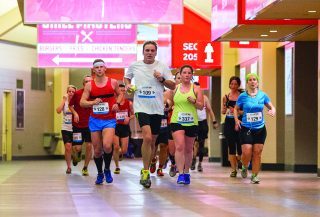
Arena Attack Hartford, Photo: Courtesy of Arena Attack
For most Minnesotans, winter means subzero temperatures, slippery roads, snowy trails and limited daylight. Dick Daymont refers to it as marathon season.
He created and now runs the Zoom! Yah! Yah! each January, which he believes is the oldest indoor marathon in the country. Runners can escape the cold, the snow and the dark, and run 26.2 miles in a climate-controlled, well-lighted space—with more than 600 aid stations along the route. You just have to run 150 laps on a 282-meter indoor track at St. Olaf College.
“Yes, it’s a lot of turns,” Daymont says. “But you change direction every 30 minutes. And you have a personal volunteer to keep track of your laps. All you have to do is run.”
The Zoom! Yah! Yah! Is just one of a number of indoor marathons that bring runners inside during the winter to get their racing in while the outdoors are inhospitable to running. To call it a trend would probably go too far—these races tend to draw dozens of people and are only held in colder climates between November and March.
“Outdoor marathons get tens of thousands of people,” says Scott Sutter, who organizes the Arena Attack at the XL Energy Center in Hartford, Conn. On the other hand, far fewer run an indoor marathon every year.
Daymont says he came up with the idea for his indoor marathon “over two or three beers.” The 67-year-old teacher, who has run more than 100 marathons, was talking with friends about creating a fundraiser for St. Olaf’s track team, which his wife coached.
“We thought, let’s do a marathon at Carleton College on Saturday, and a marathon at St. Olaf on Sunday,” he recalls. “The Carleton marathon died a quick death, but this will be our 12th year at St. Olaf.”
The name plays off the St. Olaf fight song, “Um Yah Yah” (YouTube it, you’ve probably heard it before)—and had the benefit of being a recruiting tool for runners.
“I had a friend who wanted to do a marathon for every letter of the alphabet,” Daymont says. “He needed a Z, so we thought, ‘Why not?’”
Sutter, who ran on track and cross country teams at The Citadel, graduated and moved to New England.
“There was nothing going on in the winter, from a race perspective,” he says. He recalled running practices being moved inside the fieldhouse during rainy or humid weather in South Carolina, and he thought the nearby XL Center might be a good venue.
“Almost on a whim, I called them up, and they called me back like five minutes later, and were very open to the idea,” he says. “I told my wife, ‘I think I just rented the XL Center.’”
The Arena Attack series is now in its fifth year, featuring a marathon, half marathon and 5K run. Sutter added a new event at the Mullins Center in Amherst, Mass., this year.
For runners, there are several benefits to doing an indoor marathon in addition to the
climate control: no hills, as much on-course food and water as you need, easy bathroom access and constant companionship. One thing you can’t do, however, is qualify for the Boston Marathon—indoor race times aren’t accepted there.
“There’s a lot of fellowship at an indoor race,” Sutter says. “There’s a feeling that we’re all in this together.”
RELATED: Winter Running Advice From the Coldest Places in America
Indoor marathons being held in the U.S. this winter:
MN Indoor Marathon
Nov. 27, St. Michael, Minn.
Mnindoormarathon.com
Hawk Indoor Marathon
Dec. 18, Arlington, Va.
Hawkindoormarathon.itsyourrace.com
Zoom! Yah! Yah!
Jan. 8, Northfield, Minn.
St. Olaf College
Zoomyahyah.com
Arena Attack Hartford
Jan. 21, Hartford, Conn.
XL Energy Center
Sneaa.org
Icebreaker Indoor Marathon and Half Marathon
Jan. 28, Milwaukee, Wis.
Pettit National Ice Center
Indoormarathon.com
Polar Bear Indoor Marathon and Half Marathon
Jan. 29, Ada, Ohio
Ohio Northern University
Onu.edu/indoormarathon
Maple Leaf Marathon/Half Marathon
March 4-5, Goshen, Ind.
Goshen College
Mapleleafmarathon.com
Armory NYC Indoor Marathon
March 24-26, New York City
The Armory
Armorytrack.com
The post The Winter Road Racing Alternative—Indoor Marathons appeared first on Competitor.com.
Healthy Recipes from Shalane Flanagan’s Cookbook “Run Fast. Eat Slow.”

Photo: Courtesy of "Run Fast. Eat Slow."
In addition to placing sixth in the marathon at the Rio Olympics this year, Shalane Flanagan also published her first cookbook, The New York Times’ Bestseller Run Fast. Eat Slow. The four-time Olympian collaborated with chef, longtime friend and former college teammate Elyse Kopecky to share their knowledge of simple, healthy meals that have worked best for them and other athletes over the years. From more than 100 recipes in the book, we selected a nutritious soup and salad combo that’s perfect for winter.
Reprinted with permission from Run Fast. Eat Slow. by Shalane Flanagan and Elyse Kopecky. (2016, Rodale Books)
The post Healthy Recipes from Shalane Flanagan’s Cookbook “Run Fast. Eat Slow.” appeared first on Competitor.com.
Mike Wardian Wins Marathon in Vegas and Smashes Record for Fastest Marathon Dressed as Elvis
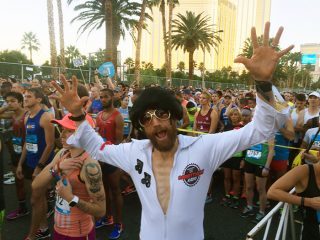
This year, Mike Wardian ran all of the World Marathon Majors and set the record for the fastest time running all six marathons in one year, averaging an amazing 2:31:09 per race. But it wasn’t over yet. He celebrated by going for one more world record: the fastest marathon ever in an Elvis costume.
On Nov. 13 at the GEICO Rock ‘n’ Roll Las Vegas Marathon, Wardian successfully beat the previous record with a time of 2:38:04. The previous record was 2:42:52, run by Ian Sharman of the UK at the 2009 Seattle Marathon.
The keys to Wardian’s success?
“One of the most important things when doing these challenges is to prepare,” he says. “You have to go and do the work. That’s what makes running awesome, if you don’t do the work, you don’t get the result.”
For Mike, this involved running in his race day costume, which got some looks. Picture a tall, thin guy in full Elvis garb, running around Washington, D.C.-area, and at what is a very fast pace for most runners.
Wardian also simulated the race day scenario in other ways. “One of the things I did was practice with the nutrition that was on course.” In this case, that meant using Gatorade Endurance formula. Additionally, because the GEICO Rock ‘n’ Roll Las Vegas race takes place in the evening, this meant that Wardian did some of his training in the evenings to acclimate to the unusual timing.
“It’s always been a goal of mine to see exactly how far I can go, how much I can push and how fast I can get. I hope I inspire people to go out and dream a little bigger and stretch from what they are comfortable with.”
RELATED: Watch Run Elvis Run, Episode 1
The post Mike Wardian Wins Marathon in Vegas and Smashes Record for Fastest Marathon Dressed as Elvis appeared first on Competitor.com.
November 17, 2016
3 Ways to Get a Grip On Winter Running
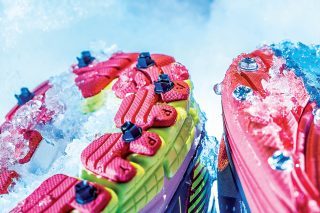
Do you live in a climate where snow and ice can make running challenging in the winter months? Here are a few shoe hacks and product suggestions to consider if your regular running routes become slippery, snowy or downright cold.
RELATED: 9 Great Waterproof Shoes for Fall/Winter Running
Photo Gallery
1 of {count}
Back to Start
View Larger Image
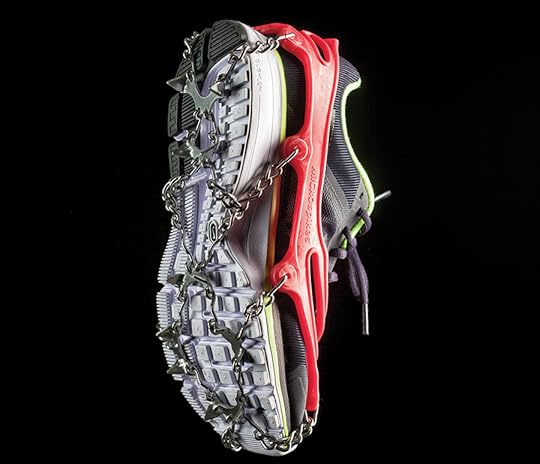
Wear cleats when you run.
Add-on cleats slide over the bottom of your shoes to improve traction in wintry
conditions. Stabilicers Run ($43) have an aggressive tread, and nine cleats help prevent slipping on icy surfaces. Yaktrax Pro ($30) have steel coils wrapped around a rubber frame that offer traction on show and ice, while Kahtoola Microspikes ($70) combine steel spikes and chains for the most rugged winter conditions. The advantage with these products is that you can continue wearing your favorite shoes without permanently altering them. Photo: Scott Draper
View Larger Image
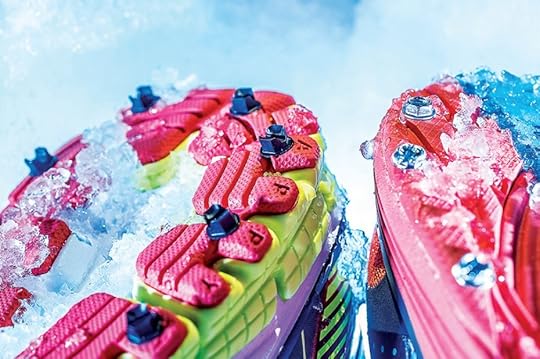
Add spikes to your shoes.
Inserting spikes or screws into a pair of running shoes can help provide traction in winter conditions. You can buy an
IceSpike Deluxe Package ($30), which includes 32 notched, composite spikes and a wrench for installing the spikes into your shoes. Or you can take the do-it-yourself approach with a handful of hex-head sheet metal screws ($3 from a local hardware store). After pre-drilling 12 holes around the perimeter of the bottom of each shoe with a 1/16-inch drill bit, hand-twist the screws until they are secure at the base of the outsole. Photo: James Carney
View Larger Image
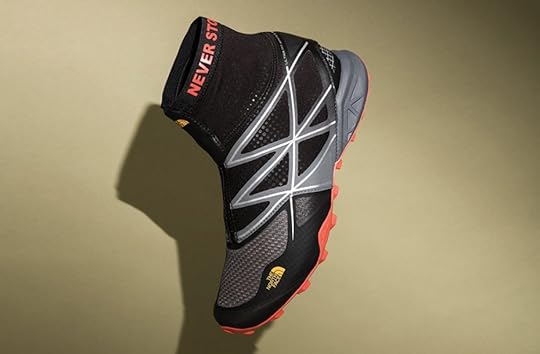
Buy winterized running shoes.
Icebug Anima5 Bugrip ($180) and Salomon Spikecross 3 CS ($170) are both lightweight, easy-flexing shoes with a durable, weatherproof upper and unrelenting traction from an array of sharp carbide-tipped studs embedded in the outsole. New to the market this season are several high-top weatherproof running shoes. Although none has built-in traction features aside from specially formulated outsole rubber compounds, The North Face Ultra MT Winter ($170), Hoka One One Tor Speed 2 Mid WP ($150) and Altra Lone Peak NeoShell Mid ($160) offer warmth and protection for running in cold, sloppy conditions. Photo: Oliver Baker

More Galleries
The post 3 Ways to Get a Grip On Winter Running appeared first on Competitor.com.
7 Fixes to Get Faster Now

Photo: Istockphoto.com
It’s one thing to have big plans for the coming year. It’s another to put those into immediate action and give yourself a leg up on your spring fitness during the fall and winter. You know you need to follow a training schedule, set goals and assess at the end of the year. But those things all take time before you’ll see improvements. So what can you do right now to get faster? “There are probably 30 things I could tell you that are actionable right now,” says Jason Fitzgerald, a Denver-based USATF-certified coach and author of 101 Simple Ways to Be a Better Runner. Thirty is a lot. Let’s start with just seven, with cues from Fitzgerald and longtime Chicago-based running coach Jenny Hadfield.
1. Mix up the effort.
One of the easiest ways for most runners to get faster is to simply “get away from the plain Jane training plan,” Hadfield says. Instead of just running the same pace all the time, vary the intensity and distances. Do one workout per week that’s high-intensity—whether that’s on the track, treadmill or hills—and do one workout each week that’s more of a tempo effort. “It’s amazing how much people improve in just two to four weeks,” says Hadfield, by just adding pace variety into their routine.
2. Mix up everything else too.
It’s not just your pace that needs a little more pizzazz. Variety is the spice of running. Regularly run in different types of shoes, rotating through two to three pairs, Fitzgerald says. This subtly changes the stress on muscles and tendons in your lower leg, which reduces the risk of injury. That’s also true for running on different surfaces: dirt, grass, bike path, asphalt. By varying the type of work you’re doing—and, yes, also different kinds of cross-training—you’ll improve your functional strength and overall biomechanics.
RELATED: Add Variety to Your Training
3. Add 10–15 minutes of core.
You know you should be doing strength work. But it can be hard to make it to a gym. Instead, just add 10–15 minutes of an assortment of plank exercises after your run a few times each week. Fitzgerald has his runners do a routine that includes planks, side planks, planks where you pick up one arm then the other, then planks where you pick up one leg then the other, pushups, and a plank position where you bring your knee up to your opposite elbow. Add simple core exercises after your run and it’ll actually get done. The winter is also an ideal time to try different kinds of workouts, Hadfield says, like yoga, strength classes or cross-country skiing.
RELATED: 11 Plank Exercises That Build Core Strength for Runners
4. Run more.
Sometimes getting faster at running is as simple as just running more. Fitzgerald says he’s often surprised how many runners aren’t doing a proper long run. Either they’re cutting it short to be social or they’re just running a couple miles longer than their other runs. He’s also found that a lot of runners are only running 15–20 miles a week. That’s fine, but “if you’re stuck in a rut and your volume’s been the same for a long time, then gradually increasing your mileage can see big improvements,” Fitzgerald says. The key is to increase the mileage gradually and then level off once you hit your new appropriate amount—say 30–40 miles per week, depending on what other training you do and your injury history.
5. Stop the static before a run.
Fitzgerald also gets rid of any static stretching his runners are doing before their runs. Plenty of studies have now shown pre-workout static stretching—i.e., touching your toes or sitting on the ground with your legs in front of you—is not helping and might be actually hurting you, as it increases the chance of injury. Instead, do a dynamic warm-up routine. This is especially helpful when it’s cold outside. That could mean some easy movement or jogging, followed by dynamic stretches like leg swings or lunges or air squats. In the winter, Fitzgerald will even have his runners do all this inside before heading out.
RELATED: Dynamic Drills and Stretching
6. Do strides.
Add to the list of ways to mix it up: running strides at the end of your workouts. “Too many runners are not doing strides,” Fitzgerald says. Running four to six strides of about 75–100 meters each helps develop proper form, and improves leg speed and turnover, he says. Aim to do this at least once per week, though Fitzgerald prefers his runners do strides two or three times each week. Over approximately 75–100 meters, gradually build up to 90–95 percent of your max speed, hold that effort for 10–15 meters, and then coast to a stop. Rest or jog for about one minute, and then repeat.
7. Forget about pace.
It sounds like wisdom from Mr. Miyagi: To go faster, stop trying to go faster. But sometimes that’s exactly what runners need, Hadfield says. “We’re all addicted to our apps and GPS.” When we become slaves to our devices, we forget to run according to how we feel. On a hot and humid day, your pace might be significantly slower for the same effort, she says. By forcing her runners to run based on heart rate, perceived effort and feel, they learn how that relates to pace. Leaving the GPS device behind sometimes allows you to go as easy as you should on easy days—which keeps you ready to go as hard as you should on hard days.
RELATED: 6 Ways to Become a Faster Runner Without Running a Step
The post 7 Fixes to Get Faster Now appeared first on Competitor.com.
Why “Serious” Runners Should Enjoy Fun Runs Too
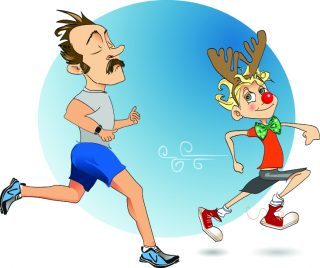
Illustration: Michelle Schrantz
My pet peeve about runners—yes, I’m looking straight into a mirror as I write this—is that we have a tendency to take ourselves a bit too seriously. This may be out of necessity, as it’s hard to get out of bed in the darkness and speed around the neighborhood on foot every morning if you don’t have faith that you’re doing something really worthwhile. Maybe even a touch noble.
The perfect antidote to self-seriousness, I’ve found, is getting smoked by a high-school cross-country runner who’s wearing a paper pilgrim hat. Holiday fun runs range from goofy Turkey Trots to inebriated New Year’s Eve races and the ridiculously hot events held on the Fourth of July. Nobody has ever qualified for the Boston Marathon or made the U.S. Olympic Trials based on a result from a race that offers a honeyed ham as the grand prize. That’s the beauty of these things.
Personally, I’m not a big costume guy. Sometimes I picture myself wearing antlers, a flashing red-and-green bowtie or some other whimsical accessory, but somehow a “Bah, humbug!” erupts in my brain and stops me. Plus, where do you even find those kinds of kitsch? Beats me, but I really do enjoy the goofy, creative and occasionally far-too-revealing costumes that the true revelers wear.
There are other reasons to celebrate fun runs. It’s good to see friends and neighbors shuffling toward a start line, rosy cheeked and brushing snow from each other’s jackets. Several times at local races I’ve had occasion to exclaim things like, “Carl’s lousy at keeping up his yard but he’s got a dynamite finishing kick.” Good finishes make good neighbors, and they give you something to talk about months later at a block party.
Then there’s your family. Holidays often bring an uncomfortable amount of indoor time, fussing about with inane projects like stringing lights on perfectly nice-looking trees or creating wreaths from dead plants. A holiday race can get everyone out of the house for some much-needed exercise and fresh air. Sure, Uncle Ralph may overcook his 5K effort and spend the rest of the holiday sporting a limp, but everyone will laud him heartily and look the other way if he hits the eggnog too hard.
There’s plenty of time during the rest of the year to build ambitious training schedules, ramp up the miles and try to nail the big race you’ve been targeting. Don’t make that mistake with your holiday fun run. Get out there and chase that kid in the damn pilgrim hat. This year he’s toast!
Contributing editor Mark Eller placed 13th out of 14 runners in a Thanksgiving 5K his wife organized in their neighborhood last year.
RELATED: 19 Wild and Wacky Fun Runs
The post Why “Serious” Runners Should Enjoy Fun Runs Too appeared first on Competitor.com.
Malty Beverages Have a Special Place in Many Runners’ Hearts

Two-time U.S. Olympian Nick Symmonds is also a noted beer aficionado and a fast beer mile runner. Photo: John Jefferson
Beer and running. It seems to be the latest rage, but it’s neither recent nor exclusive to the sport of running. Runners are not, of course, the only sporting community that claims a special affinity for beer. Hockey players have been known to down a few Molsons or Labatts, eh? Mountain bikers seem to enjoy their extra-skunky microbrews, and some adult softball leagues make the Hash House Harriers (a tradition started by British expats in Southeast Asia that combines drinking games with running) look like an abstinence program.
Many humans the world over enjoy the alcoholic drink made from yeast-fermented malt and flavored with hops, as they have for millennia. (It should be said that for some people, particularly those with certain diseases or a family history of problems with alcohol, imbibing beer or any other form of alcohol is a really bad idea.) The running community is, more or less, part of the human race and therefore beer has been adopted into many of our own traditions.
RELATED: Ghost Runners Brewery is All About the Running Lifestyle
Is beer’s significance to runners a good thing or a bad thing? The answer you receive will certainly depend on who you ask. Rod Dixon, the gifted and versatile Kiwi who won Olympic bronze in the 1500 in 1972 and won the New York City Marathon in 1983, once said, “All I want to do is drink beer and train like an animal.” On the other hand, Frank Shorter, who won Olympic gold in 1972 and silver in 1976 (both times in the marathon) has written about the abuse he suffered at the hands of his alcoholic father.
Beer has both good and bad qualities, it would seem. Here’s a short list of some of the upsides and downsides from a runner’s perspective.
RELATED: Serving Up Fresh Brews with Running Shoes
The Good
Much has been written about the health benefits of moderate red wine consumption, but some of that praise can be directed to beer as well. The ethanol in beer has been shown to lower LDL (bad) cholesterol and raise HDL (good) cholesterol. Beer consumption may also reduce the risk of kidney stones, and it provides a respectable dose of B vitamins, including folate, niacin and riboflavin.
(Cue the “Mmm…riboflavin,” murmur from Homer Simpson.) Drinking beer is also associated with higher bone density, perhaps because of the high silicon content.
VIDEO: Colorado’s Shoes & Brews Running Store
The OK
Downing a cold one immediately after a hard run or race isn’t the best idea if you’re looking for optimal recovery. Multiple studies suggest that alcohol impedes tissue repair and decreases the amount of glucose your aching muscles will absorb. However, most beer isn’t as dehydrating as you may have feared. A typical pilsner-style beer contains 4-6 percent alcohol, which means there’s a lot of water to counteract the diuretic effects. One recent study found that athletes who rehydrated with a moderate amount of beer after running for an hour in a heated room showed “no deleterious effects on markers of hydration in active individuals.” Does that mean you should rehydrate only with beer? Probably not.
RELATED: Running the NYC Marathon 5 Boroughs, 5 Beers Style
The Ugly
Alcohol abuse and alcoholism are major risk factors in human health. Remember that everyone’s physiology is different—so a few post-run beers (preferably chased with some water) might be an enjoyable celebration for one runner, but it might be a beer too much for somebody else, and for another person even one drink could be a disaster. One drink is usually equal to 12–16 ounces of beer, 5 ounces of wine or 1.5 ounces of distilled spirits. Know your limits, and strive for a healthy, moderate approach to alcohol consumption.
RELATED: More Beer and Running Articles
The post Malty Beverages Have a Special Place in Many Runners’ Hearts appeared first on Competitor.com.
Kara Goucher’s Thoughtful Advice to Her Younger Self
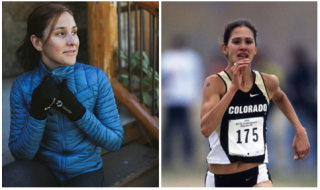
Kara Goucher of today offers some running advice to Kara Goucher of her college career at Colorado. Photos: Oiselle.com
In anticipation of the NCAA Division I Cross Country Championships on Nov. 19 in Terre Haute, Ind., professional runner Kara Goucher wrote an inspiring blog that offered advice to her much younger self. Her alma mater, the University of Colorado, is ranked No. 1 among women’s teams and No. 2 in the men’s competition heading into this weekend’s championships.
Goucher, a three-time NCAA champion in track and cross country while at Colorado, wrote some calming advice to her 22-year-old self as she was on the eve of the 2000 NCAA Cross Country Championships and some of what she penned could be useful for just about any runner in any race, no matter you age, competitive level or type or race.
Goucher won the NCAA title that year, but it came a year after a disappointing 9th-place finish the year before. Foremost among her tips is to relax and enjoy the moment.
“As the future you, I want to tell you to slow down. Try to really take it all in,” Goucher writes. “Take a deep breath, look around you, and take it all in,” she adds.
Read all of what Goucher has to say at her Oiselle blog here.
The post Kara Goucher’s Thoughtful Advice to Her Younger Self appeared first on Competitor.com.
GEICO Rock ‘n’ Roll Las Vegas Half Marathon Teaser
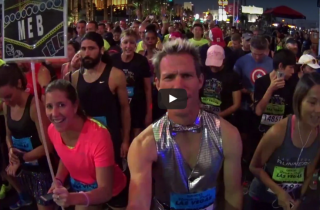
Here’s a glimpse at the action and energy in the 2016 GEICO Rock ‘n’ Roll Las Vegas Half Marathon. The 2017 event weekend is set for Nov. 11-12. For more details, click here.
The post GEICO Rock ‘n’ Roll Las Vegas Half Marathon Teaser appeared first on Competitor.com.
November 16, 2016
Which State is the Most Active in the United States?
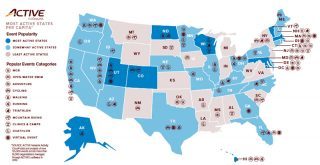
North Dakota and Washington D.C. were the most active places in the U.S. last year. Source: ACTIVE Network
Which state is the most active in the U.S.? You might be surprised.
Although states like Colorado, California and New York are often lauded for their active populations and great places for recreational activities, those aren’t the states that came up as the most active according to data from ACTIVE Network’s endurance event registration platform. That data came from all event categories in 2015, including running, cycling, swimming, triathlon, duathlon, walking, mountain biking and adventure events.
The infographic above showcases the most active states (and includes Washington D.C.) in the U.S. per capita based on that data.
Here are the top 10 most active states, based on per capita endurance event registrations:
1) North Dakota
2) Washington D.C.
3) Hawaii
4) Vermont
5) Maryland
6) Colorado
7) Wisconsin
8) Alaska
9) Massachusetts
10) Utah
Here are the top 10 least active states in the U.S., based on the per capita endurance sports registrations from the Active Network.
1) Arkansas
2) West Virginia
3) Mississippi
4) South Dakota
5) Wyoming
6) Virginia
7) South Carolina
8) Montana
9) Louisiana
10) Oklahoma
The post Which State is the Most Active in the United States? appeared first on Competitor.com.
Ryan Hall's Blog
- Ryan Hall's profile
- 21 followers



